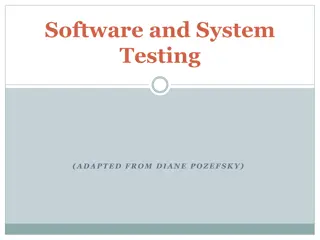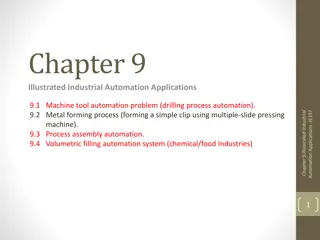Introduction to Software Testing and Automation
Software testing is the process of assessing software functionality to ensure it meets desired expectations. It helps identify defects early, improves product quality, enhances customer trust, detects security vulnerabilities, and saves costs. Different types of software testing methods are employed, with a focus on dynamic and static testing. Software testing is crucial in the engineering field to guarantee high-quality software products that meet user requirements.
Download Presentation

Please find below an Image/Link to download the presentation.
The content on the website is provided AS IS for your information and personal use only. It may not be sold, licensed, or shared on other websites without obtaining consent from the author.If you encounter any issues during the download, it is possible that the publisher has removed the file from their server.
You are allowed to download the files provided on this website for personal or commercial use, subject to the condition that they are used lawfully. All files are the property of their respective owners.
The content on the website is provided AS IS for your information and personal use only. It may not be sold, licensed, or shared on other websites without obtaining consent from the author.
E N D
Presentation Transcript
SOFTWARE TESTING AND AUTOMATION UNIT -1 - INTRODUCTION
What is software testing? Software testing is the process of assessing the functionality of a software program. The process checks for errors and gaps and whether the outcome of the application matches desired expectations before the software is installed and goes live.
The following are important reasons why software testing techniques should be incorporated into application development: Identifies defects early Improves product quality Increases customer trust and satisfaction Detects security vulnerabilities Helps with scalability Saves money
Types of software testing the two main categories are dynamic testing and static testing. Dynamic testing is an assessment that's conducted while the program is executed; static testing examines the program's code and associated documentation. Dynamic and static methods are often used together.
Testing as an Engineering Activity Software systems are becoming more challenging to build. New methods, techniques, and tools are becoming available to support development and maintenance tasks. Because software now has such an important role in our lives both economically and socially, there is pressure for software professionals to focus on quality issues Highly qualified staff ensure that software products are built on time, within budget, and are of the highest quality with respect to attributes such as reliability, correctness, usability, and the ability to meet all user requirements.
Using an engineering approach to software development implies that: The development process is well understood; Projects are planned; Life cycle models are defined and adhered to; Standards are in place for product and process; Measurements are employed to evaluate product and process quality; Components are reused; Validation and Verification processes play a key role in quality determination; Engineers have proper education, training, and certification.
Testing as a process Step-1: Assess Development Plan and Status This initiative may be prerequisite to putting together Verification, Validation, and Testing Plan wont to evaluate implemented software solution. During this step, testers challenge completeness and correctness of event plan. Based on extensiveness and completeness of Project Plan testers can estimate quantity of resources they re going to got to test implemented software solution.
Step-2: Develop the Test Plan Forming plan for testing will follow an equivalent pattern as any software planning process. The structure of all plans should be an equivalent, but content will vary supported degree of risk testers perceive as related to software being developed. Step-3: Test Software Requirements Incomplete, inaccurate, or inconsistent requirements cause most software failures. The inability to get requirement right during requirements gathering phase can also increase cost of implementation significantly. Testers, through verification, must determine that requirements are accurate, complete, and they do not conflict with another.
Step-4: Test Software Design This step tests both external and internal design primarily through verification techniques. The testers are concerned that planning will achieve objectives of wants, also because design being effective and efficient on designated hardware. Step-5: Build Phase Testing The method chosen to build software from internal design document will determine type and extensiveness of testers needed. As the construction becomes more automated, less testing are going to be required during this phase. However, if software is made using waterfall process, it s subject to error and will be verified. Experience has shown that it s significantly cheaper to spot defects during development phase, than through dynamic testing during test execution step.
Step-6: Execute and Record Result This involves testing of code during dynamic state. The approach, methods, and tools laid out in test plan are going to be wont to validate that executable code actually meets stated software requirements, and therefore the structural specifications of design. Step-7: Acceptance Test Acceptance testing enables users to gauge applicability and usefulness of software in performing their day-to-day job functions. This tests what user believes software should perform, as against what documented requirements state software should perform.
Step-8: Report Test Results Test reporting is continuous process. It may be both oral and written. It is important that defects and concerns be reported to the appropriate parties as early as possible, so that corrections can be made at the lowest possible cost. Step-9: The Software Installation Once test team has confirmed that software is prepared for production use, power to execute that software during production environment should be tested. This tests interface to operating software, related software, and operating procedures.
Step-10: Test Software Changes While this is often shown as Step 10, within context of performing maintenance after software is implemented, concept is additionally applicable to changes throughout implementation process. Whenever requirements changes, test plan must change, and impact of that change on software systems must be tested and evaluate. Step-11: Evaluate Test Effectiveness Testing improvement can best be achieved by evaluating effectiveness of testing at top of every software test assignment. While this assessment is primarily performed by testers, it should involve developers, users of software, and quality assurance professionals if function exists within the IT organization.
Testing Axioms In software testing field, there are several so called fundamental truths which every tester should know and keep during checking mobile or web software products. These statements are verified and supported by constant practice and the rich experience of various testers. Testing Axioms Are the Following: The complete testing is impossible. The quality control is always risk-based. The absence of bugs cannot be shown with the help of testing. One discovered error causes the appearance of many other bugs. An unexperienced tester may believe that he is able to detect all bugs of the software product. He issure that no errors, any at all, will be missed. But it is impossible to check every system element, every input variable, etc.
Why Is It Impossible to Completely Test a Product? The quantity of potential input combinations is huge. In accordance, the number of possible outputs is very large too. The amount of available paths through the software is huge. The product specification is not objective. A tester may discover an issue, but a stakeholder does not find it to be a real bug. The whole life is not enough to check all test conditions and develop a perfect product. To check every product aspect may require even the work of whole generation of testers. So a specialist should keep this statement in mind during functional testing or performance testing.
As it is not possible to check all test scenarios, then the untested areas will be certainly left. That is why software testing is a risk-based activity. One cannot know where there may be bugs and where not. If a tester misses a serious bug and discovers it after the release, then the cost of this bug will be very high. Usually bugs do not appear one by one, sometimes they are interconnected. A tester should be careful when he has discovered one error during black box testing or usability testing, because nearby there may be several more bugs. It can be easily explained.
Why May Bugs Follow Each Other? It was a bad day for a programmer. Thedeveloper s low spirit or a bad mood influences the quality of work. In such a case, the code will be raw. People are slaves of their habits. The developers may repeat the same mistake again and again. One bug may be only the tip of the iceberg. At first sight, some bugs may seem to be unrelated. But if one examines them closely and deep, he will find out that the whole design or architecture does not match the specification at all.
Software Testing Principles 1. Testing shows the presence of defects 2. Exhaustive testing is not possible 3. Early testing 4. Defect clustering 5. Pesticide paradox 6. Testing is context-dependent 7. Absence of errors fallacy 8. Testing Is a Risk-Based Activity 9. Testing Cannot Prove Software Correctness 10.Absence-of-Error Fallacy 11.Automated Testing Complements Manual Testing 12.Testing Is Iterative
Testing shows the presence of defects: The goal of software testing is to make the software fail. Software testing reduces the presence of defects. Software testing talks about the presence of defects and doesn t talk about the absence of defects. Software testing can ensure that defects are present but it can not prove that software is defect-free. Even multiple testing can never ensure that software is 100% bug-free. Testing can reduce the number of defects but not remove all defects. Exhaustive testing is not possible: It is the process of testing the functionality of the software in all possible inputs (valid or invalid) and pre-conditions is known as exhaustive testing. Exhaustive testing is impossible means the software can never test at every test case. It can test only some test cases and assume that the software is correct and it will produce the correct output in every test case. If the software will test every test case then it will take more cost, effort, etc., which is impractical.
Early Testing: To find the defect in the software, early test activity shall be started. The defect detected in the early phases of SDLC will be very less expensive. For better performance of software, software testing will start at the initial phase i.e. testing will perform at the requirement analysis phase. Defect clustering: In a project, a small number of modules can contain most of the defects. The Pareto Principle for software testing states that 80% of software defects come from 20% of modules.
Pesticide paradox: Repeating the same test cases, again and again, will not find new bugs. So it is necessary to review the test cases and add or update test cases to find new bugs. Testing is context-dependent: The testing approach depends on the context of the software developed. Different types of software need to perform different types of testing. For example, The testing of the e- commerce site is different from the testing of the Android application.
Absence of errors fallacy: If a built software is 99% bug-free but does not follow the user requirement then it is unusable. It is not only necessary that software is 99% bug-free but it is also mandatory to fulfill all the customer requirements. Testing Is a Risk-Based Activity: Testing efforts should be prioritized according to the risks associated with different features or functionalities. Focus testing on areas that are critical to the success of the application.
Testing Cannot Prove Software Correctness: Testing demonstrates the presence of defects but cannot prove that the software is entirely correct. It provides confidence in the software s behavior within the scope of the tests performed. Absence-of-Error Fallacy: The absence of detected defects does not proof that the software is error-free. It implies that the testing process has not found any issues within the defined scope and constraints
Automated Testing Complements Manual Testing: Combining Both automated and manual testing allows for more comprehensive test coverage. Testing Is Iterative: Testing is an iterative process that continues throughout the software development life cycle.
The Tester's Role in a Software Development Organization The tester s job is to Reveal defects, Find weak points, Inconsistent behavior, Circumstances where the software does not work as expected. It is difficult for developers to effectively test their own code. A tester needs very good programming experience in order to understand how code is constructed, and to know where andwhat typesof,defectscouldoccur.
A tester should work with the developers to produce high-quality software that meets the customers requirements. Teams of testers and developers are very common in industry, and projects should have a correct developer/tester ratio. The ratio will vary depending on Available resources, Type of project, TMM level.(Test Maturity Model) Nature of the project Project Schedules
Origins of Defects The term defect and its relationship to the terms error and failure in the context of the software development domain. Defects have detrimental affects on software users, and software engineers work very hard to produce high- quality software with a low number of defects. But even under the best of development circumstances errors are made, resulting in defects being injected in the software during the phases of the software life cycle. Defects as shown in figure stem from the following sources
Cost of defects The cost of defects identified during Software Testing, completely depends on the impact of the defects found. The earlier the defect is found, easier and less costly it is to fix these defects. For instance, if there is a defect found in the project requirement specifications and analysis, then it is relatively cheaper to fix it. Similarly, if the defects or failures are found in the design of the software, then the product design is corrected and then re-issued. However, if these defects somehow get missed by testers and if they are identified during the user acceptance phase, then it can be way too expensive to fix such type of errors. If during the software development process, an error is made and the consequent defect is detected in the requirements phase itself, then it is relatively cheaper to fix it. This is because the software is not yet in developing stage and it is easy to make requirement specified changes.
Defect Classes,the Defect Repository, and Test Design Defects can be classified in many ways. It is important for an organization to follow a single classification scheme and apply it to all projects. Some defects will fit into more than one class or category. Because of this problem, developers, testers, and SQA staff should try to be as consistent as possible when recording defect data. The defect types and frequency of occurrence should be used in test planning, and test design. Execution-based testing strategies should be selected that have the strongest possibility of detecting particular types of defects. The four classes of defects are as follows, Requirements and specifications defects, Design defects, Code defects, Testing defects
1. Requirements and Specifications Defects The beginning of the software life cycle is important for ensuring high quality in the software being developed. Defects injected in early phases can be very difficult to remove in later phases. Since many requirements documents are written using a natural language representation, they may become Ambiguous, Contradictory, Unclear, Redundant, Imprecise.
Some specific requirements/specification defects are: 1.1 Functional Description Defects The overall description of what the product does, and how it should behave (inputs/outputs), is incorrect, ambiguous, and/or incomplete. 1.2 Feature Defects Features is described as distinguishing characteristics of a software component or system. Feature defects are due to feature descriptions that are missing, incorrect, incomplete, or unnecessary.
1.3 Feature Interaction Defects These are due to an incorrect description of how the features should interact with each other. 1.4 Interface Description Defects These are defects that occur in the description of how the target software is to interface with external software, hardware, and users.
Design Defects Design defects occur when the following are incorrectly designed, System components, Interactions between system components, Interactions between the components and outside software/hardware, or users It includes defects in the design of algorithms, control, logic, data elements, module interface descriptions, and external software/hardware/user interface descriptions. The design defects are, 2.1 Algorithmic and Processing Defects These occur when the processing steps in the algorithm as described by the pseudo code are incorrect. 2.2 Control, Logic, and Sequence Defects Control defects occur when logic flow in the pseudo code is not correct.
2.3 Data Defects These are associated with incorrect design of data structures. 2.4 Module Interface Description Defects These defects occur because of incorrect or inconsistent usage of parameter types, incorrect number of parameters or incorrect ordering of parameters. 2.5 Functional Description Defects The defects in this category include incorrect, missing, or unclear design elements.
2.6 External Interface Description Defects These are derived from incorrect design descriptions for interfaces with COTS components, external software systems, databases, and hardware devices. Coding Defects Coding defects are derived from errors in implementing the code. Coding defects classes are similar to design defect classes. Some coding defects come from a failure to understand programming language constructs, and miscommunication with the designers.
Algorithmic and Processing Defects Code related algorithm and processing defects include Unchecked overflow and underflow conditions, Comparing inappropriate data types, Converting one data type to another, Incorrect ordering of arithmetic operators, Misuse or omission of parentheses, Precision loss, Incorrect use of signs.
Control, Logic and Sequence Defects This type of defects include incorrect expression of case statements, incorrect iteration of loops, and missing paths. 3.3 Typographical Defects These are mainly syntax errors, for example, incorrect spelling of a variable name that are usually detected by a compiler or self-reviews, or peer reviews.
3.4 Initialization Defects This type of defects occur when initialization statements are omitted or are incorrect. This may occur because of misunderstandings or lack of communication between programmers, or programmer`s and designer`s, carelessness, or misunderstanding of the programming environment. Data-Flow Defects Data-Flow defects occur when the code does not follow the necessary data-flow conditions. 3.6 Data Defects These are indicated by incorrect implementation of data structures.
Module Interface Defects Module Interface defects occurs because of using incorrect or inconsistent parameter types, an incorrect number of parameters, or improper ordering of the parameters. 3.8 Code Documentation Defects When the code documentation does not describe what the program actually does, or is incomplete or ambiguous, it is called a code documentation defect.
Resource usage, Interrupts handling, Data exchanges with hardware, Protocols, Formats, Interfaces with build files, Timing sequences. External Hardware, Software Interfaces Defects and exception These defects occur because of problems related to System calls, Links to databases, Input/output sequences, Memory usage,
Testing Defects Test plans, test cases, test harnesses, and test procedures can also contain defects. These defects are called testing defects. Defects in test plans are best detected using review techniques. 4.1 Test Harness Defects In order to test software, at the unit and integration levels, auxiliary code must be developed. This is called the test harness or scaffolding code. The test harness code should be carefully designed, implemented, and tested since it is a work product and this code can be reused when new releases of the software are developed.
Test Case Design and Test Procedure Defects These consists of incorrect, incomplete, missing, inappropriate test cases, andtestprocedures.
DEFECT EXAMPLES:-The Coin Problem Requirement Specification Specification for program calculate_coin_valueThis program calculates the total dollars and cents value for a set of coins. the user inputs the amount of pennies, nickels , dimes , quarters, half-dollars, and dollar coins held. There are six different denominations of coins. The program outputs the total dollar and cent values of the coins to the users Input:number_of_coinsis an integer Outputs:-number_of_dollarsis an integer Number_of_centsis an integer
A spec above shows the sample informal specification for a simple program that calculates the total money value of a set of coins. The program could be a component of an incentive cash register system to support retail store clerks. Coin Problem in Detail : (100 cent = 1 dollar) if suppose input for coin values given as 1 for all then the calculation as shown below. No of Coins (input) Coin Value 1(pennies) X 1 = 1 1 (nickels) X 5 = 5 1(dimes) X 10 = 10 1(quarters) X 25 = 25 1(half-dollars) X 50 = 50 1(dollar) X 100 = 100 191
Output No of Dollars : 1 No of Cents : 91 The given specification does not specify the above details clearly.
Developer/Tester Support for Developing a Defect Repository Software engineers and test specialists should follow the examples of engineers in other disciplines who make use of defect data. A requirement for repository development should be a part of testing and/or debugging policy statements. Forms and templates should be designed to collect the data. Each defect and frequency of occurrence must be recorded after testing. Defect monitoring should be done for each on-going project. The distribution of defects will change when changes are made to the process.
The defect data is useful for test planning. It is a TMM level 2 maturity goal. It helps a tester to select applicable testing techniques, design the test cases, and allocate the amount of resources needed to detect and remove defects. This allows tester to estimate testing schedules and costs. The defect data can support debugging activities also. A defect repository can help in implementing several TMM maturity goals including Controlling and monitoring of test, Software quality evaluation and control, Test measurement, Test process improvement.
Defect Prevention strategies is basically defined as a measure to ensure that defects being detected so far, should not appear or occur again. For facilitating communication simply among members of team, planning and devising defect prevention guidelines, etc., Coordinator is mainly responsible. Coordinator is mainly responsible to lead defect prevention efforts, to facilitate meetings, to facilitate communication between team members and management, etc. DP board generally has a quarterly plan in which sets some goals at organization level. To achieve these goals, various methods or activities are mostly used and carried out to achieve and complete these goals.























